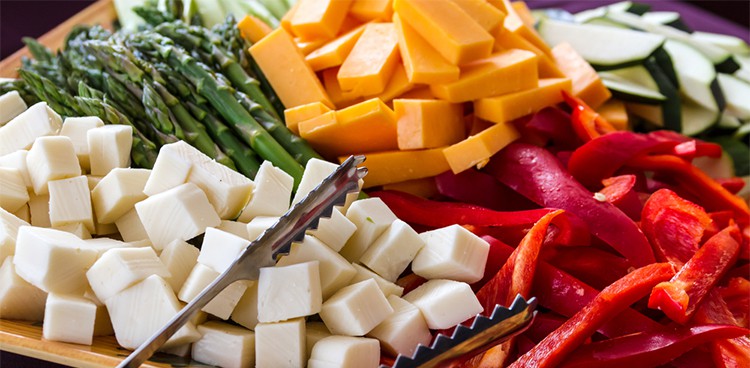
There are a few things in life that I find extremely difficult: math, taxes, job-hunting, and incorporating vegetables into a cheese plate. I love vegetables separately and I love cheese separately, but I have always been stumped when it comes to pairing them together. When I first started building cheeseboards, I just lumped a handful of cut broccoli in one spot and hoped someone would enjoy that. I was confused about the options available to me. Do carrots match with cheese? Am I supposed to use cucumber? When it comes to pairing cheese and veggies a person has to think out the box, or at least outside of the usual produce placed in the fridge.
Wisconsin Cheese has an invaluable pairing guide on their website that incorporates more cheese and veggie pairings than I’ve seen almost anywhere. And, get this, they actually look enticing! The general trick when pairing vegetables and cheese is making sure that you aren’t just putting a hunk of dry broccoli on the board. Vegetables come to life when they are roasted, sautéed, pickled, or seasoned. Sprucing up your veggies will spruce up the cheese pairing.
Sun-Dried Tomatoes

Photo Credit: “Sun-dried tomatoes” by Klearchos Kapoutsis | CC BY 2.0
Sun-dried tomatoes are the candy of the vegetable world. They’re bite-sized, pack a flavorful punch, and can be eaten as a snack all on their own. The best of these are slightly chewy and glazed with a bit of seasoned oil. These are also a bit sweet and acidic, which means they cut a thick cheese well. From our previous blog posts, we learned that heavy cheeses always do well when paired with an opposite that has a higher acidity. Pick any of your favorite rich cheeses as a match for this, and try to branch out from the obvious mozzarella. I suggest a brie or camembert, both of which have a thick, creamy consistency and high fat-content. These cheeses will benefit most from the acidity in a sun-dried tomato.
Asparagus
There’s a beautiful scene (see above) in Eat, Pray, Love where Julia Roberts’s character makes a simple lunch in Italy composed of fresh produce, including asparagus. She drizzles the asparagus in olive oil and a bit of salt before eating it alongside some tomatoes, bread, and cheese. This scene is so marvelous to me because it shows just how indulgent fresh ingredients can be if you know how to prepare them.
If you enjoy the cheeses mentioned before—brie and camembert—a pickled white asparagus would be a good choice. White asparagus tastes both sweet and sour when pickled, which helps cut the rich, creamy flavor of these soft-ripened cheeses. My favorite method of preparing asparagus is roasting. I suggest drizzling olive oil and balsamic vinaigrette on green asparagus, adding a bit of garlic, salt, and pepper. After roasting for a bit, this vegetable tastes meaty and earthy, In this form, asparagus pairs well with semi-soft cheeses like Monterey Jack or fontina.
Mushrooms

Photo Credit: “Fresh brown mushrooms” by manulito | Shutterstock
Another vegetable that benefits from a quick stint in a hot pan is the mushroom. I’ll never cease to be amazed by the contrast of a raw mushroom and a roasted one. Before being cooked, mushrooms remind me of cardboard: stiff, flaky, bland. Once cooked, mushrooms transform in texture and taste. My personal favorite mushrooms are portobello, which tend to be bigger and thicker. I’ve even used them as a meat substitute, really!
Semi-soft cheeses like muenster and havarti work well paired with roasted mushrooms. Even tossing around mushrooms in a pan with olive oil, sea salt, and oregano, will transform these vegetables. A roasted mushroom will be meaty, earthy, and have a slightly sweet note. Toss this in with arugula and you’ve got a delicious summer salad!
Olives

Photo Credit: “Olives” by Ceressa Bateman | CC BY 2.0
I’m going to be honest here and admit that I resisted olives for a long time. I found them bitter and overpowering. In my frustration, I always eyed my parents with jealousy because they loved eating olives. I began to look at olives as this sophisticated mark of adulthood.
I finally hit that mark of adulthood last fall, while living in the Netherlands. A friend and I had gone to the grocery store to pick up a simple snack: cheese, crackers, an apple. We eyed the olive container that we knew belonged alongside this picnic lunch and decided to purchase them, knowing neither of us had acquired the taste for olives yet. As soon as I put an olive in my mouth with some cheese, I understood what all the hoopla was about. The olive was peppery and salty, as well as tangy and bitter. It blew me away.
Although I tried olives in the Netherlands, they actually pair very well with Spanish cheeses. Queso fresco, cotija, and asadero all benefit from the concentrated flavor of an olive that can bring out the sweetness of the cheese.
Radishes

Photo Credit: “watermelon radish slices” by Stacy Spensley | CC BY 2.0
Honestly, I had no idea what radishes were good for prior to doing some serious vegetable research. A lone radish has always tasted pretty forgetful to me—it contains nothing more than a slight spice and crisp bite. However, the simplicity of a fresh radish can actually do wonders when paired with a rich cheese that needs just that—a crisp bite.
Pick up an aged cheddar from your local grocery store and pair it alongside thinly sliced radishes, maybe with a dash of salt. It’s not so different from pairing a thinly sliced apple with cheddar, and that’s a well-known dynamic duo.
Pitch your own veggie + cheese combo under the #culturecheesepairing and @culturecheese could pick you to win a free issue of our magazine!
Feature Photo Credit: “Large platter of hors d’oeuvres…” by Teri Virbickis | Shutterstock



